Money Supply, Gold, S&P and the "Safe Haven" Theory
Commodities / Money Supply Mar 17, 2007 - 10:09 PM GMTBy: Adrian_Ash
 ACCORDING to the laws of quantum physics, simply watching an event changes the nature of that event itself.
ACCORDING to the laws of quantum physics, simply watching an event changes the nature of that event itself.
You'll find the same phenomenon at work on Wall Street, too.
The more stock brokers follow a stock, the higher it goes. The best PR money can buy comes in the form of "independent" analysis.
Small-cap stocks suffering "absolute neglect" by professional analysts, for example, can trade at a huge discount to their more research-friendly peers. In the City of London, a study found in 2004, unloved small company stocks were seen to trade 32% lower on a valuation basis!
Outside the securities market, gold flirted with "absolute neglect" for nearly 20 years – and it traded at a growing discount to paper assets until the start of 2001. No one wanted the damn stuff all through the '80s and '90s. At least, not enough fund managers to pull the metal out of its two-decade bear market.
But "in a bleak world, gold could beat almost everything else," as Barton Biggs decided for Morgan Stanley in 2002. Empirical studies proved it and the charts showed it in action. Now that Wall Street was losing money in stocks, the brightest fund managers wanted to prove it, too.
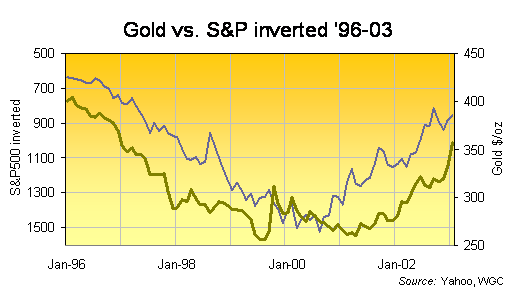
Both down and up, therefore, gold mapped the S&P – inverted – quite beautifully. The data always said it would.
Back in the mid-80s, the Harvard duo of Larry Summers and Robert Barsky had shown that gold moved inversely to the returns paid by other assets, including cash. A bull market in stocks meant a bear market in gold. Peter Palmedo at Sun Valley Gold confirmed the thesis almost a decade later.
Stocks were still going up, however, and with no risks to worry about, no one needed to diversify their risk. By the time Morgan Stanley got round to talking up gold with its clients, gold's 20-year slump had reached its end. Now stocks were sinking – and spreading your risk was the way to go.
The data proved it, remember.
By Sept. '02, gold stocks had outperformed the S&P by 43% inside 12 months! That same year, PricewaterhouseCoopers (PwC) ran a report for the Australian Gold Council saying that gold could reduce volatility for institutional investors, helping to improve the trade-off between risk and return.
If you wanted to dazzle your clients with a rising "efficient frontier", in short, gold had to figure in your portfolio. By summer 2005, when Ibbotson Associates reached the same conclusion on behalf of Bullion Marketing Services, gold had risen nearly 50% from its low – and gold's new bull market only made its "safe haven" status more attractive still.
Out of seven asset classes, said Ibbotson, only precious metals displayed a negative correlation with all the others. The World Gold Council, courtesy of New Frontier Advisors, reported the same findings in Sept. last year. It went so far, in fact, as to say that gold should enjoy a similar weighting in long-term investment portfolios as small-cap and emerging market stocks.
"Gold's diversification properties stem from its negative to low correlation with other major asset classes, including other commodities," said the WGC report. "Empirical evidence indicates that as much as a 4 percent allocation of gold...could be expected to provide strategic benefits."
Strategic benefits come into their own when tactics breakdown, of course. And here in early 2007, investors across the world lost money in stocks over the last two weeks – up to $3 trillion according to Bloomberg.
Trouble is, they lost money in gold, too. How come?
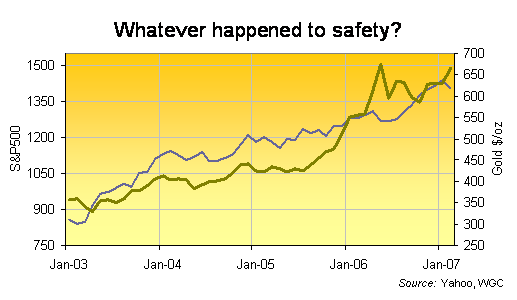
"2003 provided an exception to the rule that gold prices tend to vary inversely with those of financial assets," as John Hathaway of Tocqueville Asset Management noted at the start of 2004. Yet 2004 then proved an exception too – as did 2005 and 2006.
The action in 2007 so far only serves to beg the question more urgently still. Just what happened four years ago to kill gold's "safe haven" appeal? It joined the same trend as stocks, real estate, emerging markets and high-yield bonds – upwards.
What gives? Has something gone wrong with the data?
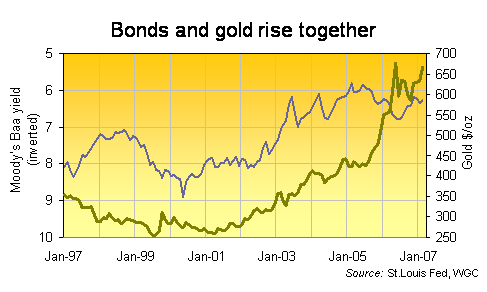
Well, in a word, yes. Gold's magical powers of diversification really did desert it four years ago. And the kryptonite that zapped its powers – forcing it rise with everything else – was the plunging cost of money.
In 2003 the European Central Bank in Frankfurt cut its base rate from 3.75% to 3.0% – and left it there for the next 30 months. The Bank of England in London slashed its lending rate to 3.5%, a forty-year low.
Three-month interbank rates on the Swiss Franc fell below 0.75%...while the US Fed famously cut Dollar rates all the way down to a half-century "emergency" low of 1%. And to complete the bonanza of cheap money, the Bank of Japan in Tokyo stuck with cheap money so cheap, it was free.
The world's 5 leading currencies couldn't be cheaper to borrow and BANG! Up went the S&P, FTSE, Dax, CAC40, SMI...even the Nikkei. The lowest global interest rates since the Depression worked magic on the price of equities in nominal terms. They pushed bond prices higher, too – and dug spurs into the gold bull market's hot flanks.
For the first time since anyone bothered to start crunching such data, gold rose together with paper assets. But does that mean gold won't protect you against falling financial prices today? Short-term, and perhaps for as long as Wall Street stays bullish on gold futures, the answer seems to be that no, it won't.
But divide the world of investment into three classes – equities, cash and non-paper money. Gold during the '70s rose as stock markets plunged and the value of money collapsed. During the '80s and '90s it sank as stocks markets rose and faith was restored in the Dollar.
Now, in spring 2007, equity prices are rising again – and so too is gold. But faith in government-controlled money has been leaking away for the last four years or more, tapped by negative real interest rates on the world's 5 leading currencies.
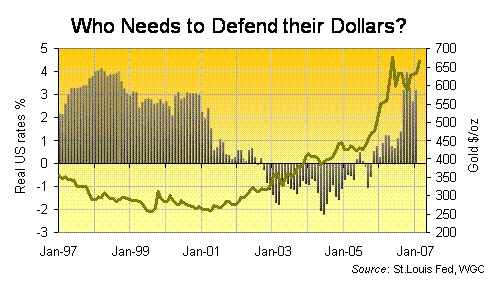
The Fed's "deflation scare" took real returns on US Dollars below zero starting in late 2002. Even Ben Bernanke would admit that. But measuring real US rates by simply deducting CPI inflation from the Fed Funds rate doesn't give you the true picture of monetary ease.
"Myriad changes introduced during the Clinton and Bush administrations have rendered this benchmark of inflation all but useless," notes John Hathaway at Tocqueville. "If computed in the same manner as it was before the Clinton administration, measured [CPI] inflation would currently exceed 5%," he says, "or twice the official rate – and real interest rates would be zero."
One way to get round the fudge is to look at Fed Funds minus nominal GDP growth instead. Inflation's still included in the result, but it's parsed by any fake growth that Washington's statisticians try to include, as well.
Above zero, the Fed's stance is restrictive; below zero, it's loose. And guess what?
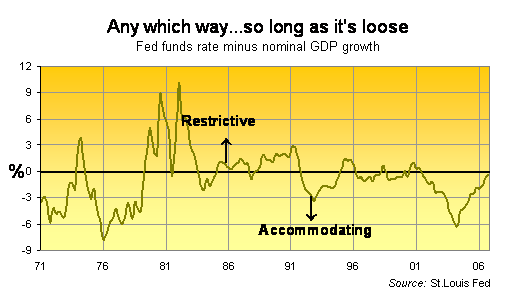
In short, the global boom in all asset prices has come thanks to one major bear market – the bear market in money. Government-led and central bank-sanctioned, it has now halved the value of US Dollars versus gold. It's pushed Sterling and Swiss Francs down 40% since 2003...knocked the Euro 30% lower in the last two years alone...and sent the Japanese Yen reeling to just two-thirds of its value since the Bank of Japan cut its rates to 0.10% in Sept. 2001.
Call it liquidity if you must, a flood that's washing the ink out of central bank promises to pay the bearer.
This bear market in money will roll on for as long as interest rates fail to outpace inflation. With the subprime mortgage market collapsing, don't expect a change anytime soon.
And for as long as holding cash keeps destroying wealth, investors everywhere will spurn money in favor of equities, real estate, junk bonds, fine art...anything that offers a capital gain.
Many short-term fund traders will also keep buying gold futures, thinking it's part of some "Reflation Rally".
But a handful of investors will buy physical bullion instead, fearing the day when money's bear market shows up in non-monetary assets.
By Adrian Ash
Adrian Ash is head of research at BullionVault.com , the fastest growing gold bullion service online. Formerly head of editorial at Fleet Street Publications Ltd – the UK's leading publishers of investment advice for private investors – he is also City correspondent for The Daily Reckoning in London, and a regular contributor to MoneyWeek magazine.
© 2005-2022 http://www.MarketOracle.co.uk - The Market Oracle is a FREE Daily Financial Markets Analysis & Forecasting online publication.


